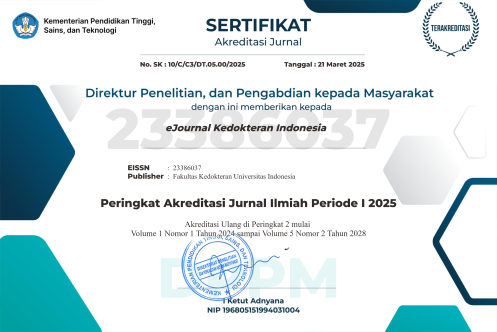Pengaruh Pajanan Auditorik Kombinasi Gelombang Monoton dan Ritmis terhadap Ekspresi Postsynapticdensity-95 Hipokampus Neonatus Ayam
DOI:
https://doi.org/10.23886/ejki.9.64.110Abstract
Ibu hamil yang terpapar bising akan memengaruhi janin yang dikandungnya bahkan memiliki efek negatif terhadap neurogenesis. Suara dari gelombang ritmis (musik) dapat meningkatkan neurogenesis yang berpengaruh langsung terhadap fungsi memori. Penelitian ini bertujuan untuk mengetahui efek positif gelombang ritmis untuk meredam atau menjadi terapi bagi bagian otak yang sebelumnya mendapat efek negatif gelombang monoton, dilihat dari peningkatan ekspresi densitas optik protein postsynapticdensity-95 dan waktu uji labirin T. Penelitian eksperimental ini dilakukan di laboratorium Developmental Biologi dan Patologi Anatomik Fakultas Kedokteran Universitas Indonesia pada bulan September 2018. Penelitian menggunakan 24 telur ayam yang difertilisasi dan dibagi empat kelompok: kelompok suara ritmis, monoton, gabungan (kombinasi suara monoton dan ritmis), dan kontrol. Telur yang sudah difertilisasi diinkubasi selama 21 hari dan dimiringkan secara otomatis tiap 4 jam. Dilakukan proses candling hari ke-3, ke-5, ke-10 dan ke-15 untuk menilai perkembangan embrio ayam. Hasil penelitian ini, terdapat perbedaan bermakna densitas optik protein postsynapticdensity 95 dan waktu uji labirin T antara kelompok gabungan dengan kelompok ritmis dan monoton, namun tidak terjadi perbedaan bermakna dengan kelompok kontrol. Gelombang ritmis dapat mengurangi efek buruk gelombang monoton dan mengembalikannya menjadi sama dengan normal (kelompok kontrol).
Kata kunci: ritmis, monoton, kombinasi suara, memori, postsynapticdensity-95.
Effect of Auditory Exposure combination of Monotonous and Rhythmic Waves on Postsynapticdensity-95 Expression on Neonatal Hippocampus
Abstract
Pregnant women who are exposed to noise will affect the fetus they contain and even have a negative effect on neurogenesis. Sound from rhythmic waves (music) can increase neurogenesis which directly affects memory function. This study aims to determine the positive effect of rhythmic waves to dampen or become therapy for parts of the brain that previously received the negative effects of monotonous waves, seen from the increase in the expression of the optical density of the postsynapticdensity-95 protein and the labyrint T test time. This experimental study was conducted in the Developmental Biology laboratory and Anatomic Pathology, Faculty of Medicine, University of Indonesia in September 2018. The study used 24 fertilized chicken eggs and divided into four groups: rhythmic, monotonous, combined (a combination of monotonous and rhythmic sounds), and control. Fertilized eggs are incubated for 21 days and automatically tilted every 4 hours. The candling process was carried out on the 3rd, 5th, 10th and 15th days to assess the development of chicken embryos. The results of this study, there was a significant difference in the optical density of the postsynaptic density protein 95 and the time of the T labyrint test between the combined group and the rhythmic and monotonous group, but there was no significant difference with the control group. Rhythmic waves can reduce the bad effects of monotonous waves and return them to normal (control group).
Keywords: rhythmic, monotone, sound combination, memory, postsynaptic density-95.
Downloads
Downloads
Published
How to Cite
Issue
Section
License
Copyright (c) 2021 Frisca Angreni, DESWATY FURQONITA, AHMAD JUSUF

This work is licensed under a Creative Commons Attribution-NonCommercial 4.0 International License.



